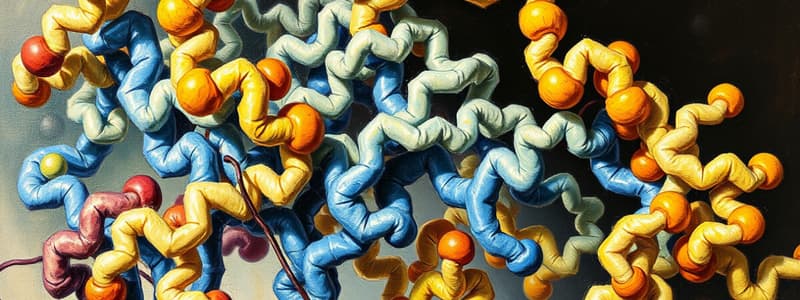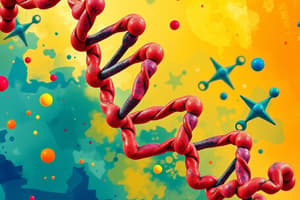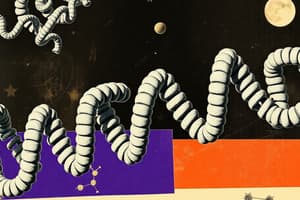Podcast
Questions and Answers
What are proteins primarily composed of?
What are proteins primarily composed of?
- Carbohydrates
- Fatty acids
- Amino acids (correct)
- Nucleotides
Which function is associated with transport proteins?
Which function is associated with transport proteins?
- Binding and carrying substances within the organism (correct)
- Catalyzing biochemical reactions
- Receiving chemical signals
- Providing physical stability
What structure level of proteins refers to the specific sequence of amino acids?
What structure level of proteins refers to the specific sequence of amino acids?
- Tertiary structure
- Secondary structure
- Primary structure (correct)
- Quaternary structure
Which type of protein is primarily responsible for regulating cellular processes as hormones?
Which type of protein is primarily responsible for regulating cellular processes as hormones?
Which statement regarding proteins is correct?
Which statement regarding proteins is correct?
What is the primary structure of a protein?
What is the primary structure of a protein?
What is likely to happen if there is a slight change in the amino acid sequence of a protein?
What is likely to happen if there is a slight change in the amino acid sequence of a protein?
Which of the following describes a polypeptide?
Which of the following describes a polypeptide?
What structure is formed when hydrogen bonds link atoms in a single chain of amino acids, resulting in a coiled shape?
What structure is formed when hydrogen bonds link atoms in a single chain of amino acids, resulting in a coiled shape?
What determines the shape of a protein and, consequently, its function?
What determines the shape of a protein and, consequently, its function?
In protein structure, what is the role of hydrogen bonds formed by the main chain groups?
In protein structure, what is the role of hydrogen bonds formed by the main chain groups?
How many amino acids are linked together in a tripeptide?
How many amino acids are linked together in a tripeptide?
Which of the following statements is incorrect regarding the structure of proteins?
Which of the following statements is incorrect regarding the structure of proteins?
What is the characteristic structure formed by hydrogen bonds linking amino acids across two chains?
What is the characteristic structure formed by hydrogen bonds linking amino acids across two chains?
What term describes the final folded shape of a globular protein?
What term describes the final folded shape of a globular protein?
What primarily drives the formation of a protein's tertiary structure?
What primarily drives the formation of a protein's tertiary structure?
Which structure results from the association of two or more polypeptide chains?
Which structure results from the association of two or more polypeptide chains?
What is meant by a protein being 'denatured'?
What is meant by a protein being 'denatured'?
Which of the following describes how a protein's final folding is determined?
Which of the following describes how a protein's final folding is determined?
In the context of protein structure, what do subunits refer to?
In the context of protein structure, what do subunits refer to?
What structure is characterized by characteristic coils and pleats formed through hydrogen bonding?
What structure is characterized by characteristic coils and pleats formed through hydrogen bonding?
What is the primary structural characteristic of proteins?
What is the primary structural characteristic of proteins?
What is a peptide bond?
What is a peptide bond?
Which group of an amino acid varies and gives it unique properties?
Which group of an amino acid varies and gives it unique properties?
How does the structure of amino acids relate to their function in proteins?
How does the structure of amino acids relate to their function in proteins?
What is the N-terminal of a polypeptide chain?
What is the N-terminal of a polypeptide chain?
What type of reaction links amino acids together to form polypeptides?
What type of reaction links amino acids together to form polypeptides?
Which of the following statements is false about polypeptide chains?
Which of the following statements is false about polypeptide chains?
How does the positive NH3+ group and negative COO– group affect amino acids?
How does the positive NH3+ group and negative COO– group affect amino acids?
Flashcards are hidden until you start studying
Study Notes
Organic Molecules: Proteins
- Proteins are large, complex molecules composed of long chains of smaller units called amino acids.
- Essential for structure, function, and regulation of tissues and organs in the body.
Four Levels of Protein Structure
-
Primary Structure:
- Specific sequence of amino acids determined by genetic information (DNA).
-
Secondary Structure:
- Involves hydrogen bonding between backbone components, resulting in structures like alpha (α) helices and beta (β) pleated sheets.
-
Tertiary Structure:
- The overall three-dimensional shape of the protein, driven by interactions among side chains (R groups), especially hydrophobic interactions.
-
Quaternary Structure:
- Formation of a functional protein from two or more polypeptide chains (subunits), which may be identical or different (e.g., hemoglobin's structure).
Amino Acids: Building Blocks of Proteins
- There are 20 different amino acids, which each possess a central carbon, amino group, carboxyl group, hydrogen atom, and a variable side chain (R group).
- The unique properties of each amino acid arise from its side chain, contributing to protein structure and function.
Peptide Bonds and Polymerization
- Peptide bonds form between amino acids through a condensation reaction, linking the amino group of one to the carboxyl group of another, releasing a water molecule.
- Chains of amino acids are classified as follows:
- Dipeptide (2 amino acids)
- Tripeptide (3 amino acids)
- Oligopeptide (4-10 amino acids)
- Polypeptide (more than 10 amino acids)
Protein Functions
- Enzymes: Catalyze biochemical reactions.
- Structural proteins: Provide stability and movement (e.g., keratin in hair).
- Signaling proteins: Control physiological processes (e.g., hormones).
- Receptor proteins: Respond to chemical signals.
- Membrane transporters: Regulate substance passage across membranes.
- Storage proteins: Store amino acids for future use.
- Transport proteins: Carry substances within the organism.
- Gene regulatory proteins: Influence gene expression rates.
Importance of Protein Shape
- The specific shape of a protein is crucial for its function; slight changes in amino acid sequence can significantly affect its structure and capabilities.
- Secondary structures result from hydrogen bonding, while the tertiary structure is determined by the nature of the amino acid side groups.
Summary of Protein Structure Mechanisms
- Assembly Process: Primary structure (sequence), Secondary structure (hydrogen bonding), Tertiary structure (folding), and Quaternary structure (interactions between polypeptides).
Studying That Suits You
Use AI to generate personalized quizzes and flashcards to suit your learning preferences.




